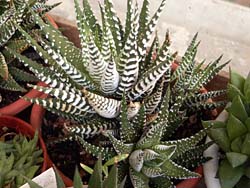Plant Family: Liliaceae
Common Name: Zebra haworthia
General Description
Comprising about 70 species of small, succulent, cold-tender perennials, this southern African genus contains many excellent subjects for containers or frost-free gardens. Most cultivated haworthias come from desert or semi-desert regions of South Africa that receive little or no summer rainfall.
Most Haworthia species form ground-hugging or short-stemmed rosettes of fleshy, somewhat triangular, firm- or soft-textured leaves. The leaves of several species (including H. cymbiformis) have a mosaic of translucent "windows" at their tips, which admit light to an interior layer of photosynthesizing cells. Warty silver-gray tubercules mark the leaves of some species (such as H. attenuata), giving them an almost reptilian appearance. Still others (H. arachnoidea, for example) produce spherical rosettes covered with a cobweb of fine white bristles. Among the most striking and sought-after haworthias are H. truncata and its allies, whose "sawed-off" leaves resemble miniature stone columns.
Many haworthias multiply rapidly into sizable clumps when grown in optimal conditions. Most have fleshy roots, but a few are tuberous-rooted.
Haworthias are not showy bloomers, producing small, pale, tubular flowers on tall, thin, wiry stems. Blooming season differs among species. Plants sometimes set seed, which if sown may result in hybrid seedlings. Many formerly supposed species of Haworthia are now known to be hybrids.
These succulents do best in porous soil and bright filtered light. Water sparingly in summer and winter, and more frequently in spring and fall. Haworthias take very well to container culture and are splendid in decorative pots. Drought and sun may cause reddening of the leaves. Plants are easily propagated by separation of rosettes.
Characteristics
- AHS Heat Zone: 12 - 10
- USDA Hardiness Zone: 10 - 15
- Sunset Zone: 12, 13, 21, 22, 23, 24
- Plant Type: Succulent
- Sun Exposure: Full Sun, Partial Sun
- Height: 1"-4" / 2.5cm - 10.2cm
- Bloom Time: Early Spring, Spring, Late Spring, Early Summer, Summer, Late Summer, Early Fall, Fall
- Native To: Southern Africa
- Soil type: Loam, Sand
- Tolerances: Drought
- Water Requirements: Keep the soil barely moist and if you use rainwater, be careful as it could be acidic. Use warm water.
- Fertilizer: Feed only twice a year, once in April and once in July with a water soluble fertilizer.
Tip &Advice: Be careful not to over-water. Put a layer of small gravel at the bottom of the pot and also one inch on the top of the soil to prevent stem rot. Repot this plant in the spring and use a shallow pot.

